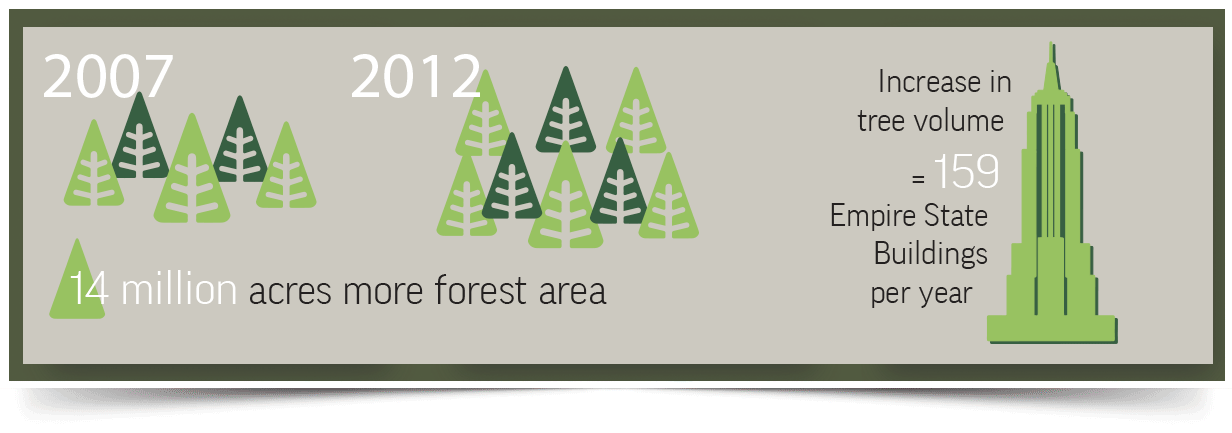

Is Going Paperless a Way to Save Trees?
In a word, no. "Going paperless" will not save North American forests. Here are five key reasons why:
- Our forests are growing due to sustainable forestry practices – In North America we grow many more trees than we harvest. For example, the forest area in the U.S. increased by 14 million acres between 2007 and 2012. That's the equivalent of 5,800 NFL football fields per day! During this time period the increase in the volume of trees on U.S. timberland could have filled 159 Empire State Buildings each year.1 In Canada, forest area remained stable over the last 2 decades at about 350 million ha; less than 0.5% of the resource is harvested annually and must be regenerated.2
- Paper production is not a main cause of forest loss (deforestation) – Deforestation means the permanent or long-term conversion of forest lands to other land uses due to urban expansion, industrial development, resource extraction or agricultural development. Worldwide by far the most significant cause of deforestation is the expansion of agriculture.3 In the U.S., the main causes are development of cropland, pasture and urban areas (particularly the southern regions). In Canada it is the expansion of agriculture and the oil and gas industry.4
Although woodland roads are a cause of deforestation, they make up a small percentage of overall forest loss and they do offer many positive recreational benefits for thousands of outdoor enthusiasts across North America (such as mountain biking, hiking, bird-watching, fishing, and hunting). - Most trees don't go into pulp and paper – In North America, the majority of wood fiber for papermaking comes from sawmill residues and recycled paper products. Only 36% of the U.S. roundwood harvest (trees) is used each year in manufacturing paper and paperboard.5 In Canada, 13% of the wood fiber to make paper comes from roundwood.6 The main product made from trees harvested in the U.S. and Canada is lumber. It is the sawmill chips (i.e. byproducts of the lumber process) that are a key raw material for pulp manufacture and eventually papermaking.
- Forest products provide an incentive for forest owners to keep land as forest – Most pulpwood harvested in the U.S. (89%) comes from private land.7 Landowners receive income from the trees grown on their land. This is an important incentive to maintain, sustainably manage and renew this valuable resource. This is especially important where landowners are facing economic pressure to convert forestland to non-forest uses, such as residential housing.8 Continued use of paper and other wood products may therefore be a key factor in maintaining a forested landscape for future generations.
- Paper is one of many products from sustainably managed forests – Due to its inherent sustainable features (renewability, recyclability, carbon uptake and storage), wood is a highly valued raw material for numerous products. In fact, the University of Kentucky - College of Agriculture has compiled a thorough list of hundreds of products made from wood.9
As paper use declines in mature markets such as North America, there may be temporary decreases in wood harvesting in some regions, until markets recover or new markets develop. These economic slow-downs are not necessarily good for privately owned forests, since forest owners lose income and may sell their forest land (see item 4 above). However, as our industry undergoes its transformation into innovative forest products and new markets, wood used for papermaking is being diverted to other uses such as dissolving pulp for textiles and consumer goods10, biomass for energy use, and even biodiesel that you can put in your car gas tank.
So, how do we protect forests?
There are a few things that many consider to be priorities:
- Provide incentives to keep forestland and continually improve sustainable forest management, as most forests across North America are not under conservation agreements or easements, and many are privately owned.
- Continue efforts to protect valuable forest areas. Today only about 10% of forests are under conservation.
- Try to minimize losses of growing stock from natural disasters such as fire, insects and disease. In 2015 in the U.S., over 10.1 million acres of forest burned and there were over 68,000 fires.11 In 2014 in Canada, over 49 million acres were damaged by insects.12 These fire losses far exceed the amount of wood harvested for forest products.
020617
1Two Sides, "Some Thought-Provoking Facts on Paper, Forests and Recycling," December 7,
2016.
2 Natural Resources Canada, "The State of Canada's Forests: Annual Report 2014."
3 Covington, Phil, "Deforestation and the Role of Paper Products," Triple Pundit, September 2013.
4 Riebel, Phil, "Let's Get the Story Straight on the State of North American Forests and Deforestation," Two Sides, November 3, 2014.
5 Dovetail Partners Inc., "Tree-Free Paper: A Path to Saving Trees and Forests?" 2014.
6 Forest Products Association of Canada, "Making the Most of Forests' Harvest: Maximizing the Paper Fibre Cycle," January 2012.
7 USDA Forest Inventory Analysis, 2012 Forest Resource Tables, September 2014.
8 World Business Council for Sustainable Development and NCASI, "The Sustainable Forest Products Industry, Carbon and Climate Change," 2007.
9 University of Kentucky College of Agriculture Cooperative Extension Service, "Products Made from Wood," 2002.
10 PPI Magazine, "Conversion boosts Sappi Cloquet mill growth strategy," August 2014.
11 Dickie, Gloria, "2015 wildfires burned a record-breaking 10.1 million acres," High Country News, January 11, 2016.
12 Natural Resources Canada, "Indicator: Forest insects," accessed January 2017.













